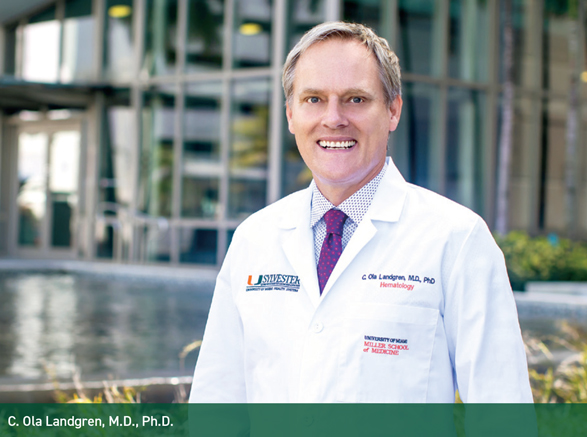A dedicated myeloma institute will help accelerate the speed of Sylvester’s research in discovery science, drug development and translational investigations.
Years ago, when C. Ola Landgren, M.D., Ph.D., joined Sylvester Comprehensive Cancer Center at the University of Miami Miller School of Medicine to lead the myeloma program, he told Sylvester’s Director Stephen D. Nimer, M.D., that his goal was to establish a “top three” U.S. myeloma program within five years.

With three years to go, Dr. Landgren is on track toward his goal. He recently announced the new, dedicated Myeloma Research Institute within Sylvester, for which he serves as the director. He is also the inaugural leader of the newly launched Translational and Clinical Oncology Research Program at Sylvester the Paul J. DiMare Endowed Chair in Immunotherapy at Sylvester and professor of medicine at the Miller School.
Together with Francesco Maura, M.D., co-leader of the Myeloma Genomic Lab at Sylvester and associate director of computational oncology research, and Dickran Kazandjian, M.D., professor of medicine at the Miller School and associate director of clinical trials research at the new institute, Dr. Landgren’s team will help accelerate Sylvester’s research in discovery science, drug development and translational investigations.
“This institute leverages Drs. Landgren, Maura, and Kazandijan’s strengths and fulfills a promise of providing the best cancer care to myeloma patients at Sylvester,” said Stephen D. Nimer, M.D., Sylvester director and executive dean for research at the Miller School and holder of the Oscar de la Renta Endowed Chair in Cancer Research.
“We recruited Dr. Landgren, a world leader in myeloma research, for his vision and expertise. He and his colleagues are working collaboratively on developing prevention methods, much-needed therapies, and cures for multiple myeloma,” said Dr. Nimer, who is also the executive dean for research at the Miller School.
Myeloma, also called multiple myeloma, is a cancer of plasma cells, which are a type of white blood cell that produces antibodies to protect against infection. However, when this cancer takes hold, the cancer cells grow out of control, crowding out healthy blood cells and producing abnormal proteins.
The American Cancer Society estimates that about 34,470 new cases of myeloma will be diagnosed in the U.S. and 12,640 will die from the cancer in 2022. Florida is among the states with the highest rates of new myeloma diagnoses in the U.S., with 7.9 cases diagnosed in every 100,000 of the state’s residents.
Dr. Landgren previously served as chief of myeloma service at Memorial Sloan Kettering Cancer Center in New York, and prior to that as chief of the myeloma program at the National Cancer Institute, National Institutes of Health (NIH) in Bethesda, Maryland. Francesco Maura, M.D., co-leader of the Myeloma Genomic Lab at Sylvester, is associate director of computational oncology research, and Dickran Kazandjian, M.D., professor of medicine at the Miller School, is associate director of clinical trials research at the new institute. The Myeloma Research Institute has produced several high-impact papers and secured invitations to open Phase 1 and Phase 2 clinical trials for promising new drugs — Sylvester is one of only a few centers in the U.S. selected to participate, according to Dr. Landgren.
“We are leading development of blood-based tracking for residual disease,” Dr. Landgren said.
The research team has validated its findings with peer-reviewed publications and has secured both philanthropic funding through a grant from the Tow Foundation and federal funding via the NIH. In addition, the center currently has more than 10 early-phase drug trials open and will open another 10 trials in the next 12 to 18 months. There has been an explosion of innovative science and early drug development in multiple myeloma at Sylvester,” Dr. Landgren said.
A dedicated myeloma institute will help to accelerate the speed of Sylvester’s research in discovery science, drug development, and translational investigations. It will serve as a training ground for future specialists and leaders in the field of multiple myeloma. The commitment to dedicate an institute to the study of this cancer type will amplify key partnerships, positively influencing philanthropic support, grant awards, and high-impact publications, according to Dr. Landgren.
Among Dr. Landgren’s research areas are studies like TRANSFORMM, which is focused on learning how to prevent multiple myeloma from becoming a disease in those at the highest risk. Prevention is key, according to Dr. Landgren, because there are no established curative therapies to treat multiple myeloma, but there could be more options if scientists can eradicate the disease before it takes hold.
“We already know that there are millions of people who have precursor disease for multiple myeloma, but only about 35,000 develop myeloma each year. Right now, we cannot treat millions of people because most would never develop the disease, and we don’t yet have screening programs to determine which patients are likely to progress,” Dr. Landgren said.“But we are making important discoveries in this area, and I think in the future, if we could identify people who have the precursor and see who is programmed to progress, we could offer treatment and probably eradicate the disease in many cases.